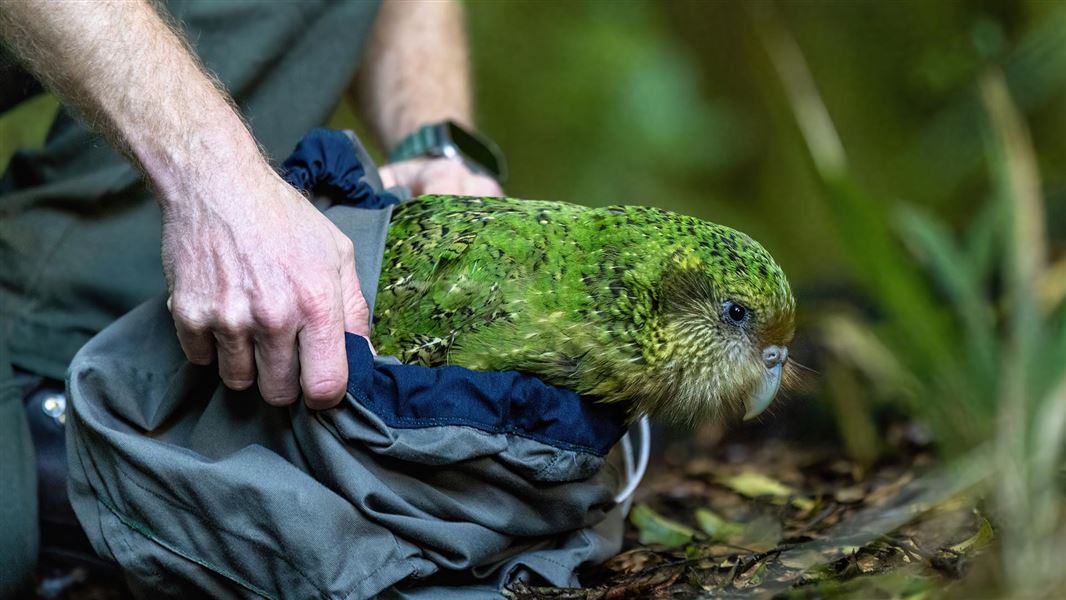Archived content: This media release was accurate on the date of publication.
Date: 28 November 2023
Following a review of bird activity, DOC, Ngāi Tahu and Sanctuary Mountain Maungatautari made the call to temporarily decrease the population at the Waikato fenced sanctuary from ten to seven birds while they develop a less labour-intensive monitoring solution.
The decision comes after the allure of the fence has proven too strong for some of the famously curious parrots, with three finding a way over it in the past two months. One kākāpō, Motupohue, who was part of the first cohort transferred in July, found his way out twice in quick succession, suggesting a behavioural component. He was relocated back to a southern predator-free island last week, along with Manawanui and Kanawera, who have not breached the fence but created a high monitoring workload by spending a lot of time near it.
DOC Operations Manager for Kākāpō Deidre Vercoe says departures from the fenced sanctuary were an expected challenge of the trial, and four in six weeks has meant an increase in monitoring was needed at a time where monitoring was expected to be significantly decreasing.
Reducing the population means staff can keep closer tabs on the nocturnal, ground-dwelling parrots while still preserving the integrity of the trial.
“The kākāpō wear transmitters and are regularly monitored by rangers, but there are some limitations with the technology - tracking their exact whereabouts can be very labour intensive and is made more difficult by terrain and weather.”
The manu are otherwise doing well within the sanctuary, Deidre says.
“All kākāpō are in good condition, passing their health checks and exploring their new territory. It’s just some of them are very interested in the fence. It could be an age thing, or a behavioural thing; we just don’t know yet.
“But that is the purpose of a trial – to prepare, watch, learn and adapt as needed and taking risks is part of that.”
Te Rūnanga o Ngāi Tahu Kākāpō Species Representative Tāne Davis says Ngāi Tahu has worked closely with ngā iwi ki Maungatautari who jointly made the decision to return the three kākāpō to their kāinga (home) in Fiordland.
“Our curious taonga will always test us. We have learnt a lot since the manu were first released on Sanctuary Mountain Maungatautari in July and I know they will continue to teach us more as they adapt to life on the mainland. These learnings are crucial if we want kākāpō to thrive within our communities and backyards in the decades to come.”
Using vegetation remains the leading theory for how the kākāpō are departing the sanctuary. Vegetation was cleared before the transfer and is ongoing.
The trial is reinforcing why we should never underestimate a kākāpō, Deidre says.
Kākāpō are flightless, and are excellent climbers that can use their wings to “parachute” from treetops. The average canopy height at Sanctuary Mountain Maungatautari is higher than in the southern islands; taller trees mean greater “parachuting” distances.
Sanctuary Mountain Maungatautari General Manager Helen Somerville says their ranger team have done an outstanding job with both monitoring the birds and vegetation clearing.
“We are learning just how clever these manu are. By now we expected the hands-on monitoring to have begun to reduce, however this hasn’t been possible and the team is traversing our incredible sanctuary every day checking on bird locations, and this method is simply not sustainable.”
Deidre says having kākāpō in a fenced sanctuary has never been done before.
“With the southern predator-free islands reaching capacity, it is vital to investigate alternative habitats ahead of future breeding seasons, so we continue to be committed to this trial.
“One of our ultimate goals is to have large numbers of kākāpō exploring their former range – wild and free, and places like Sanctuary Mountain Maungatautari are an important stepping stone for kākāpō in the meantime.”
“As with any trial there is always an element of risk, but to secure their future, we need to push the boundaries. Kākāpō have come back from the very brink of extinction to a population of just under 250 birds, but without new, safe, predator-free habitat, we won’t be able to help them continue to grow.”
Contact
For media enquiries contact:
Email: media@doc.govt.nz
